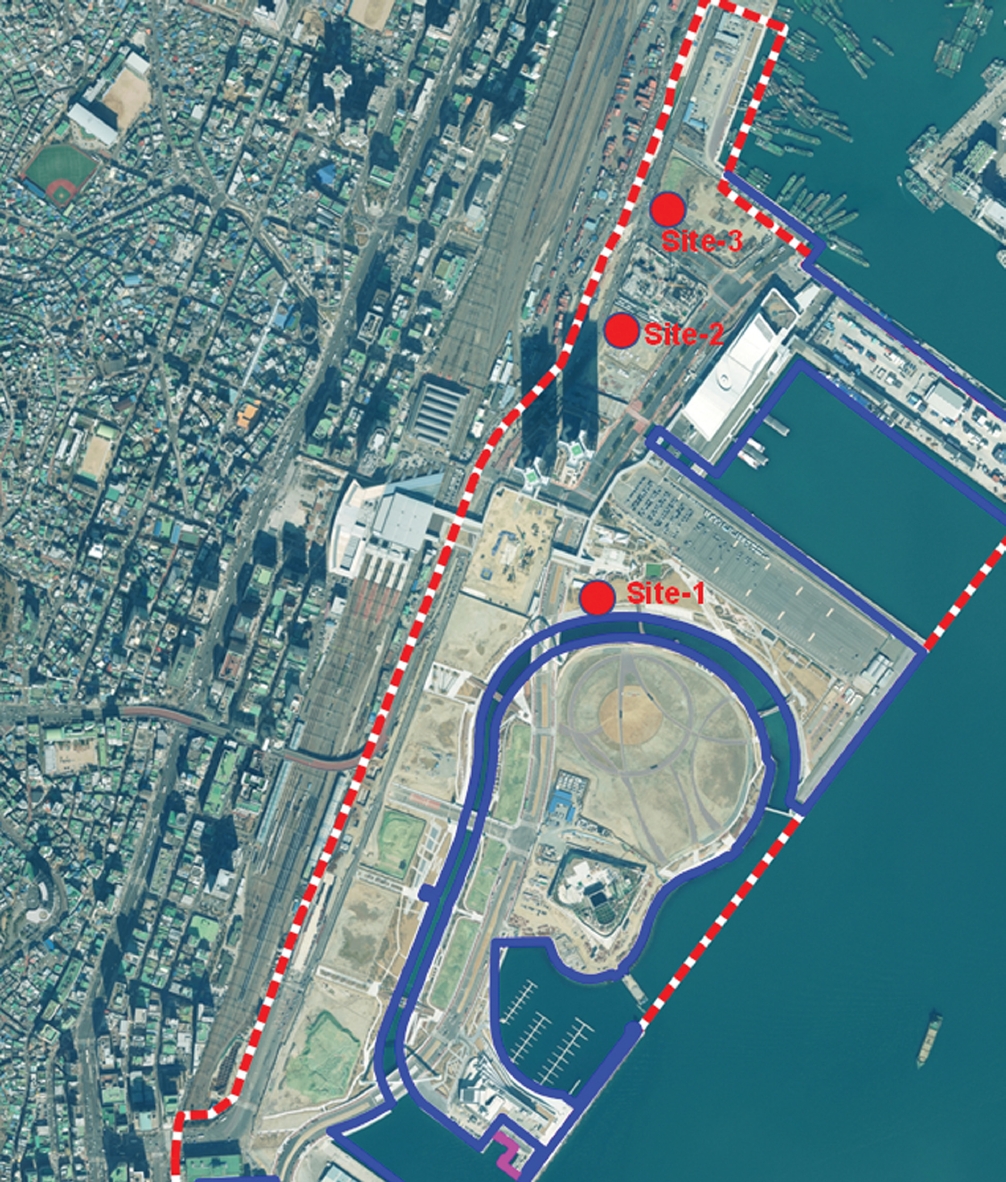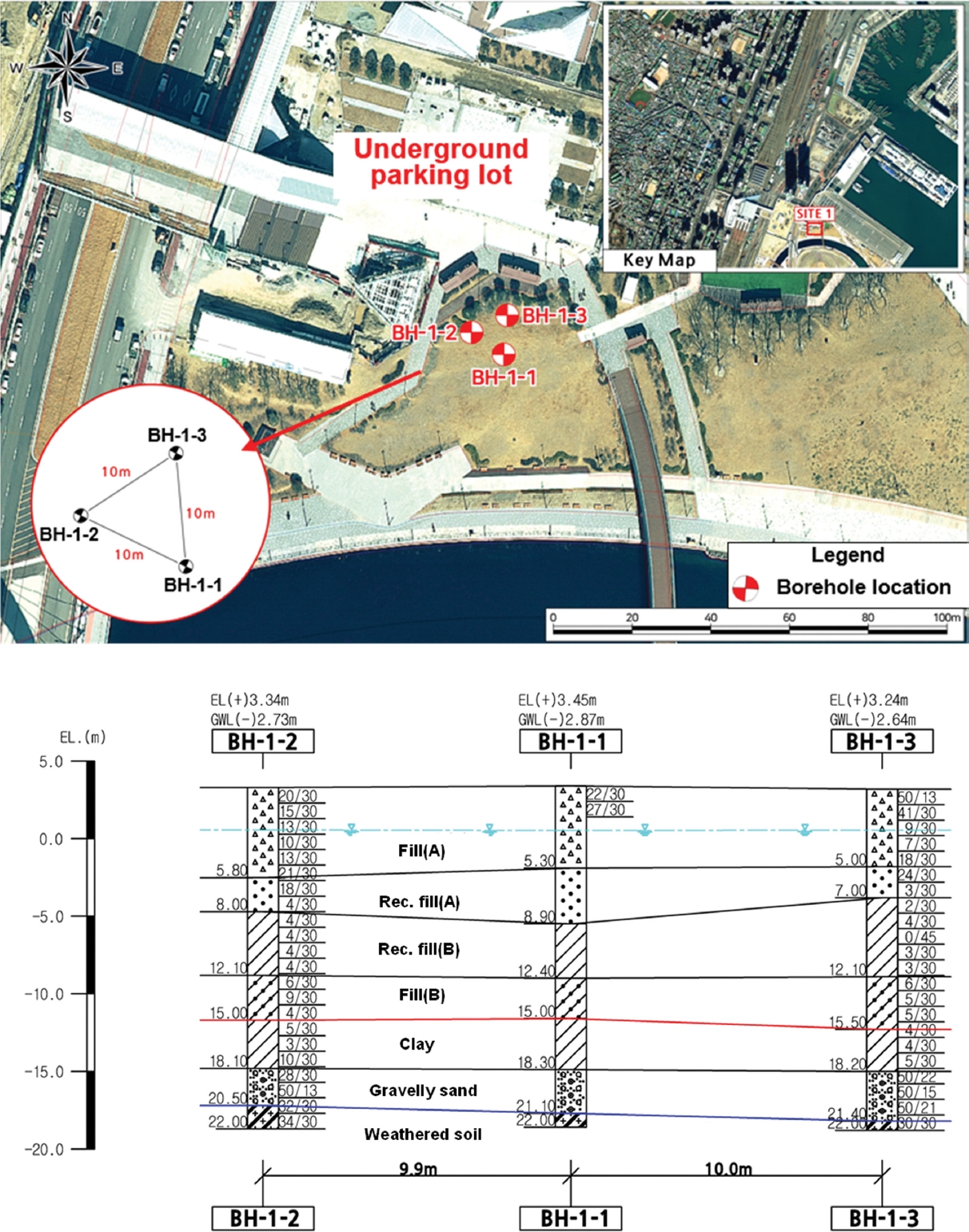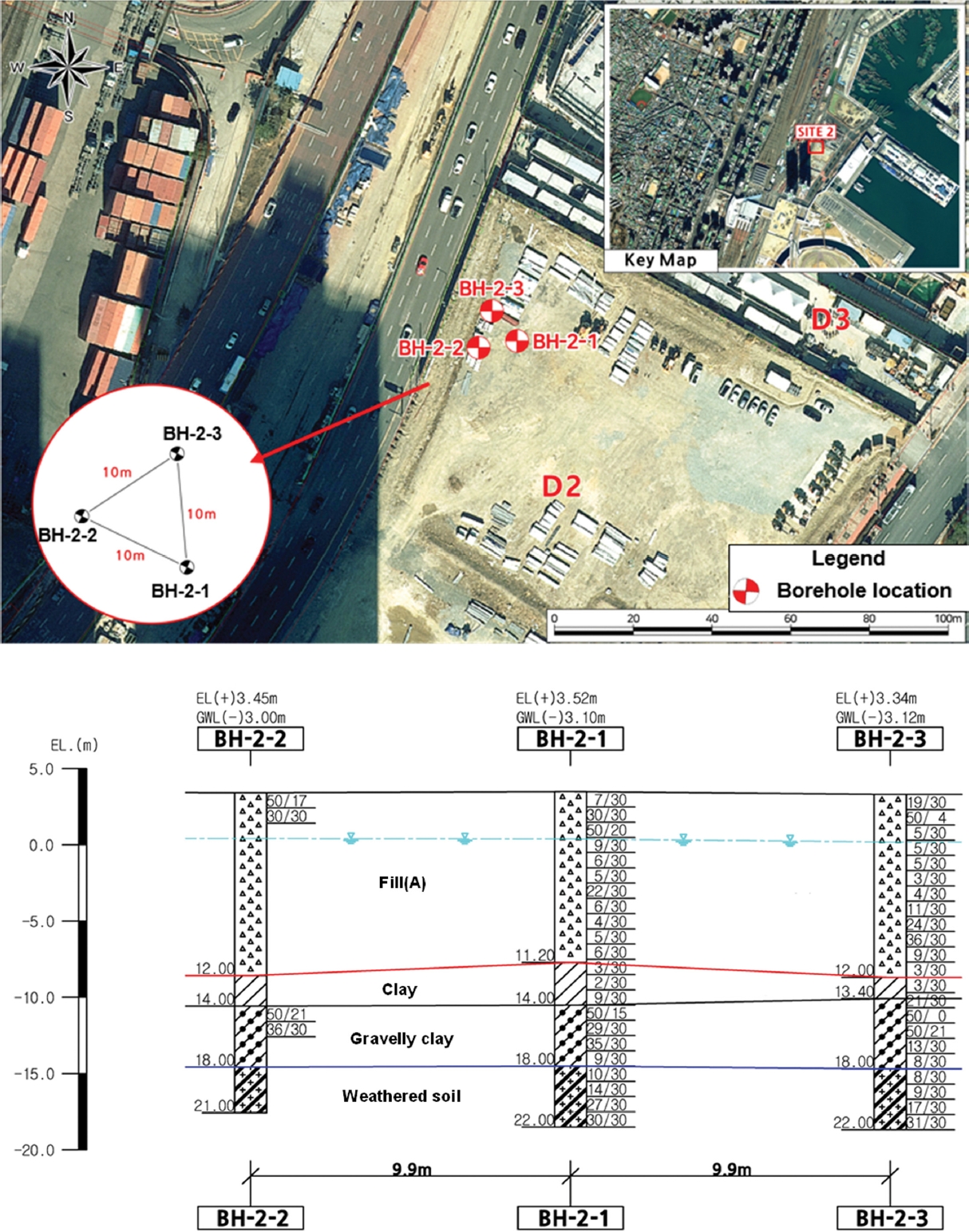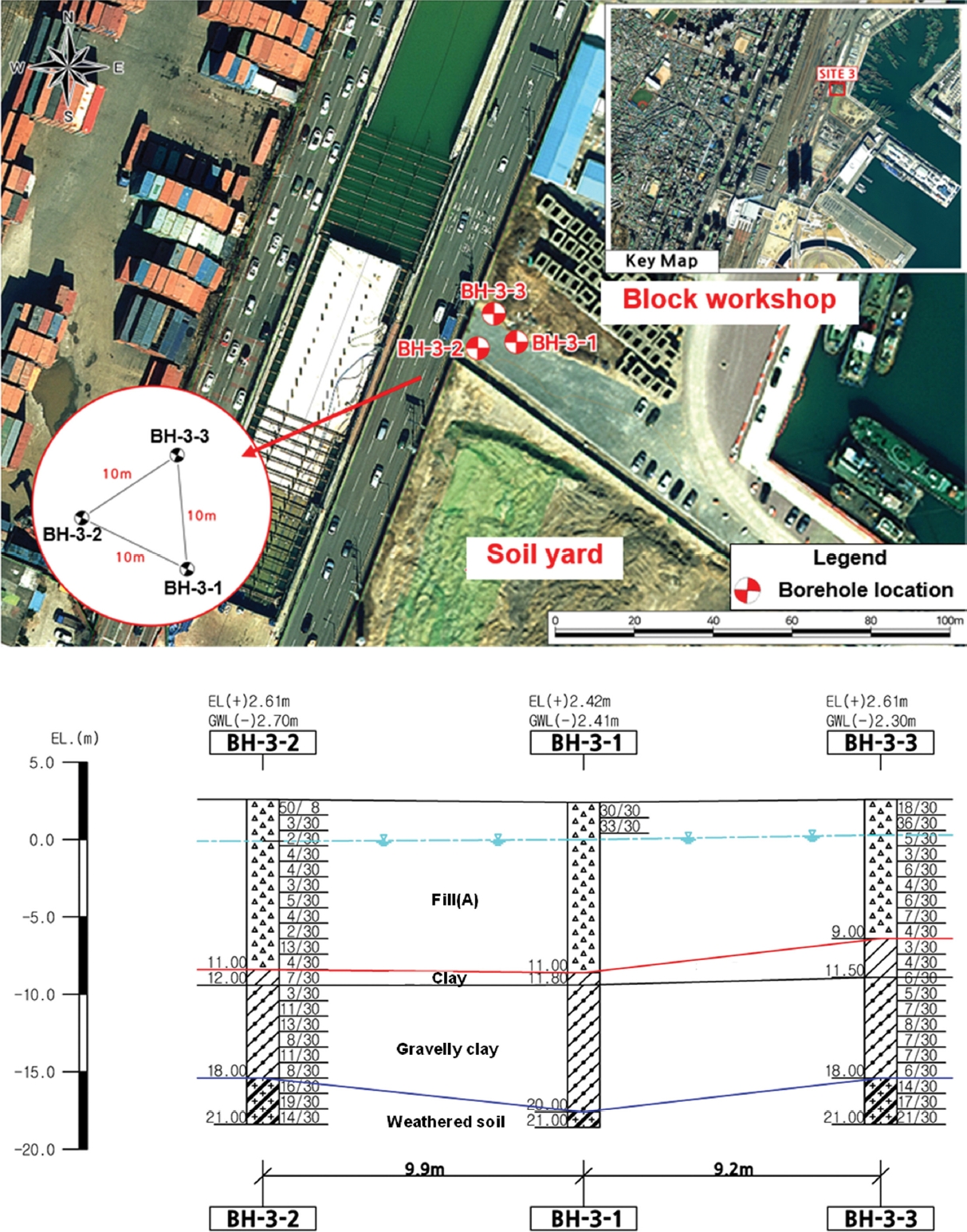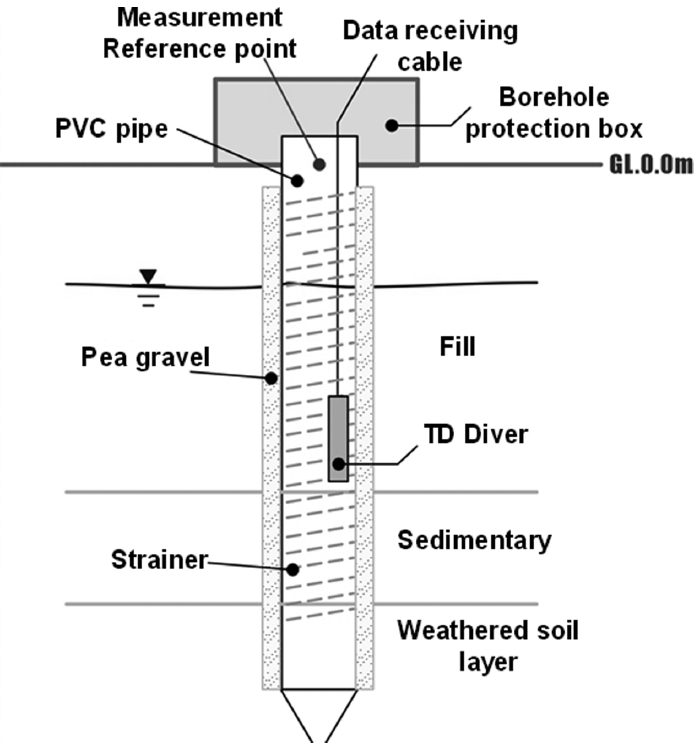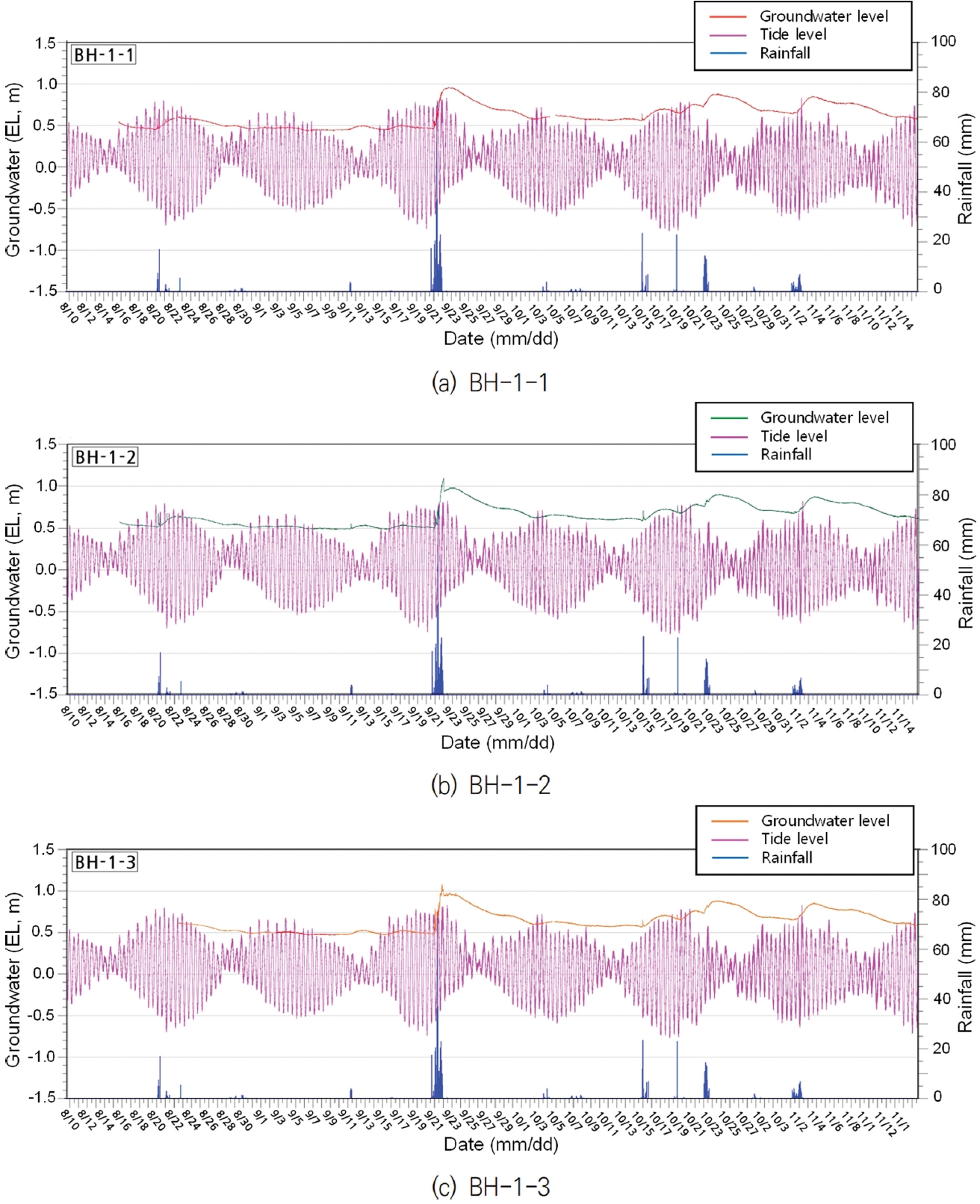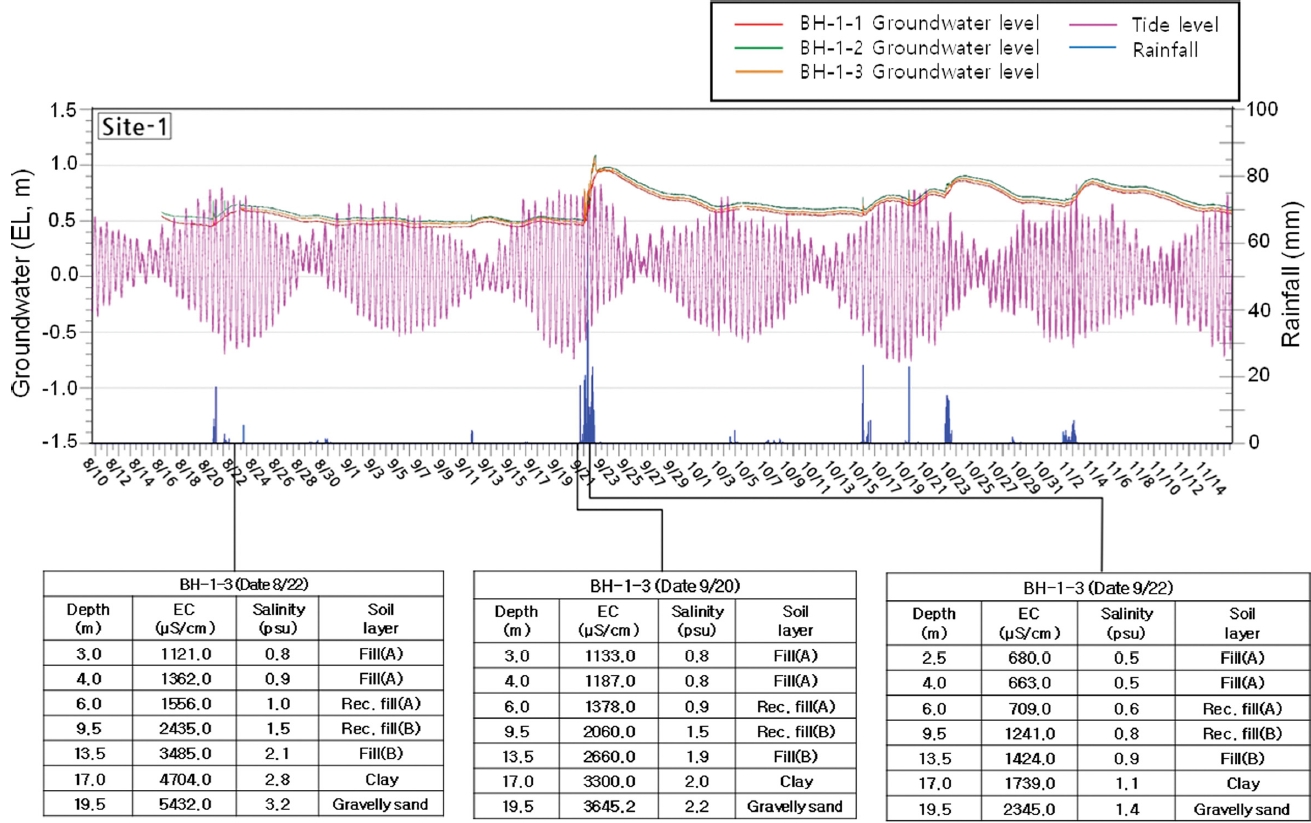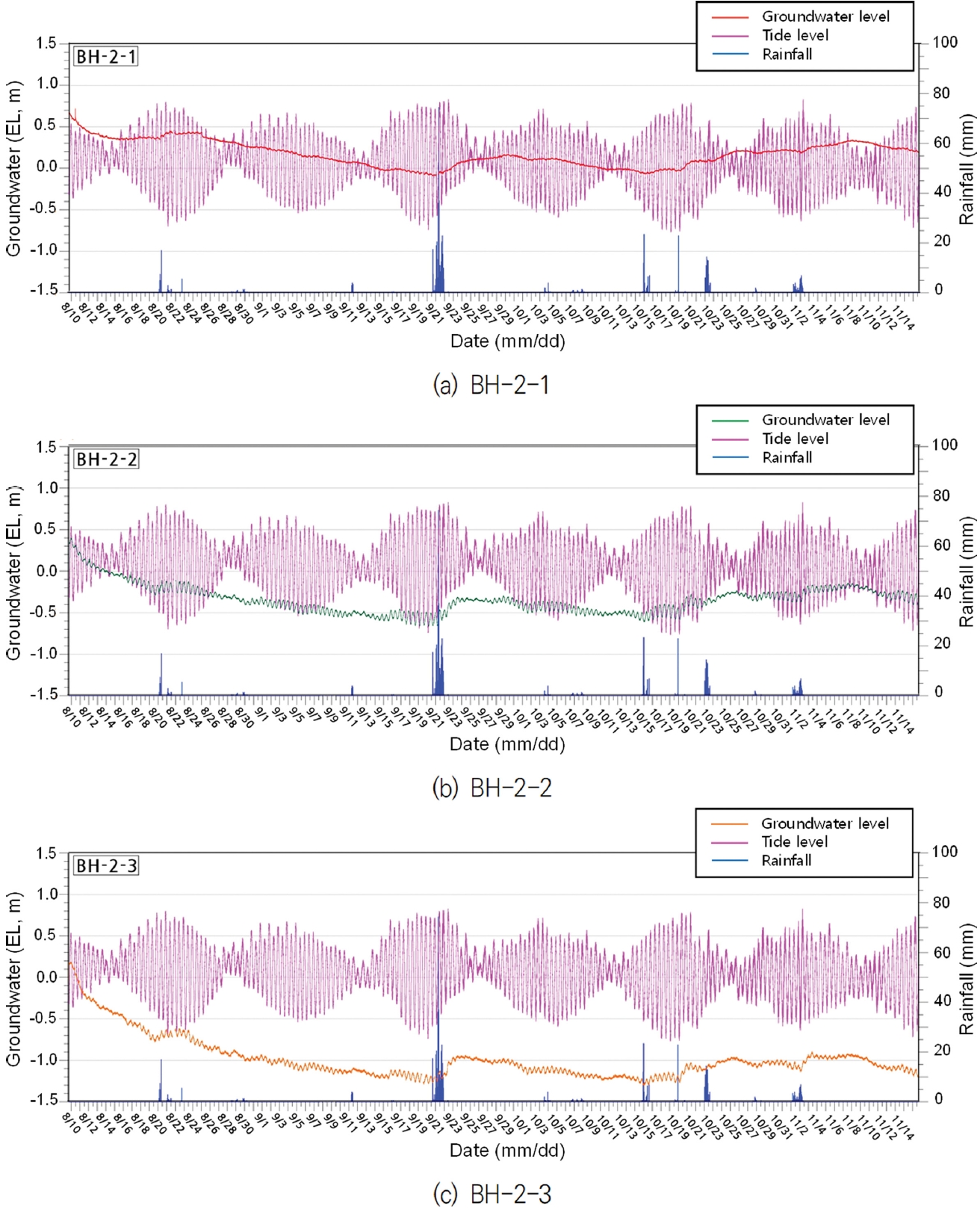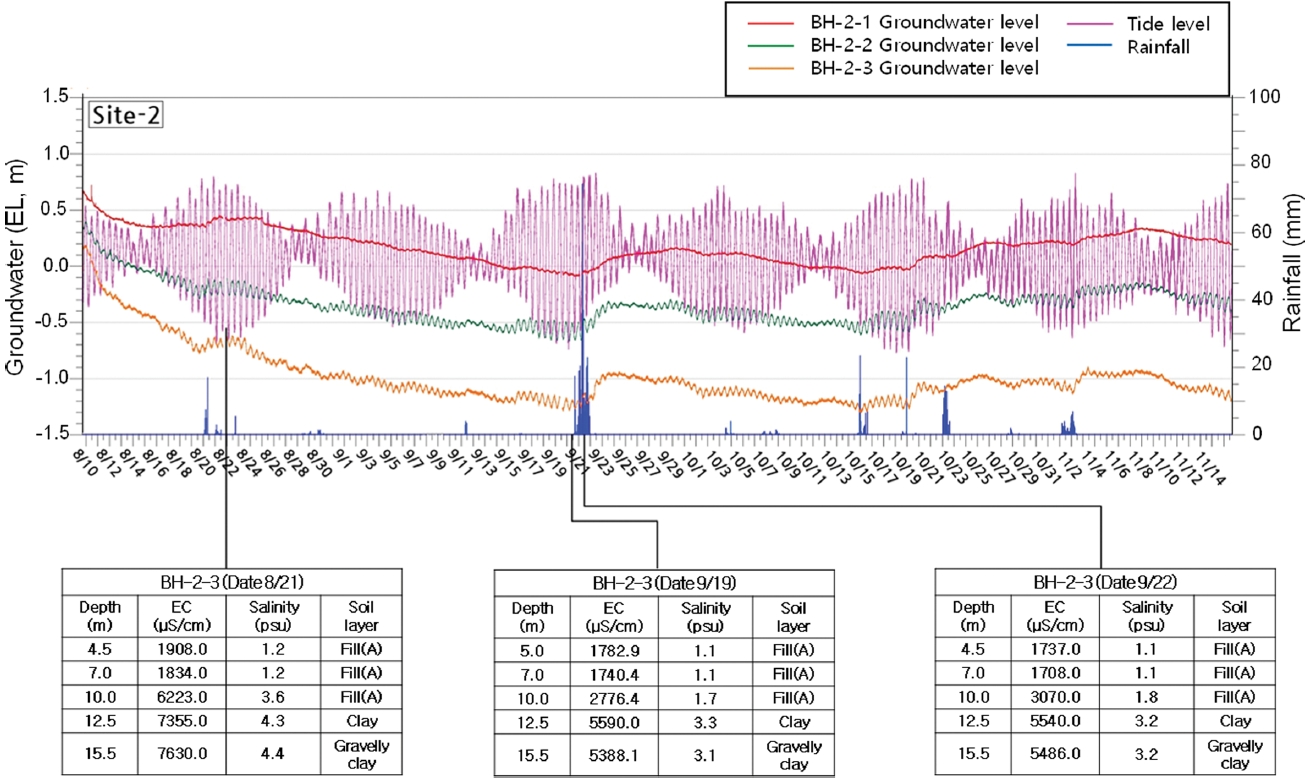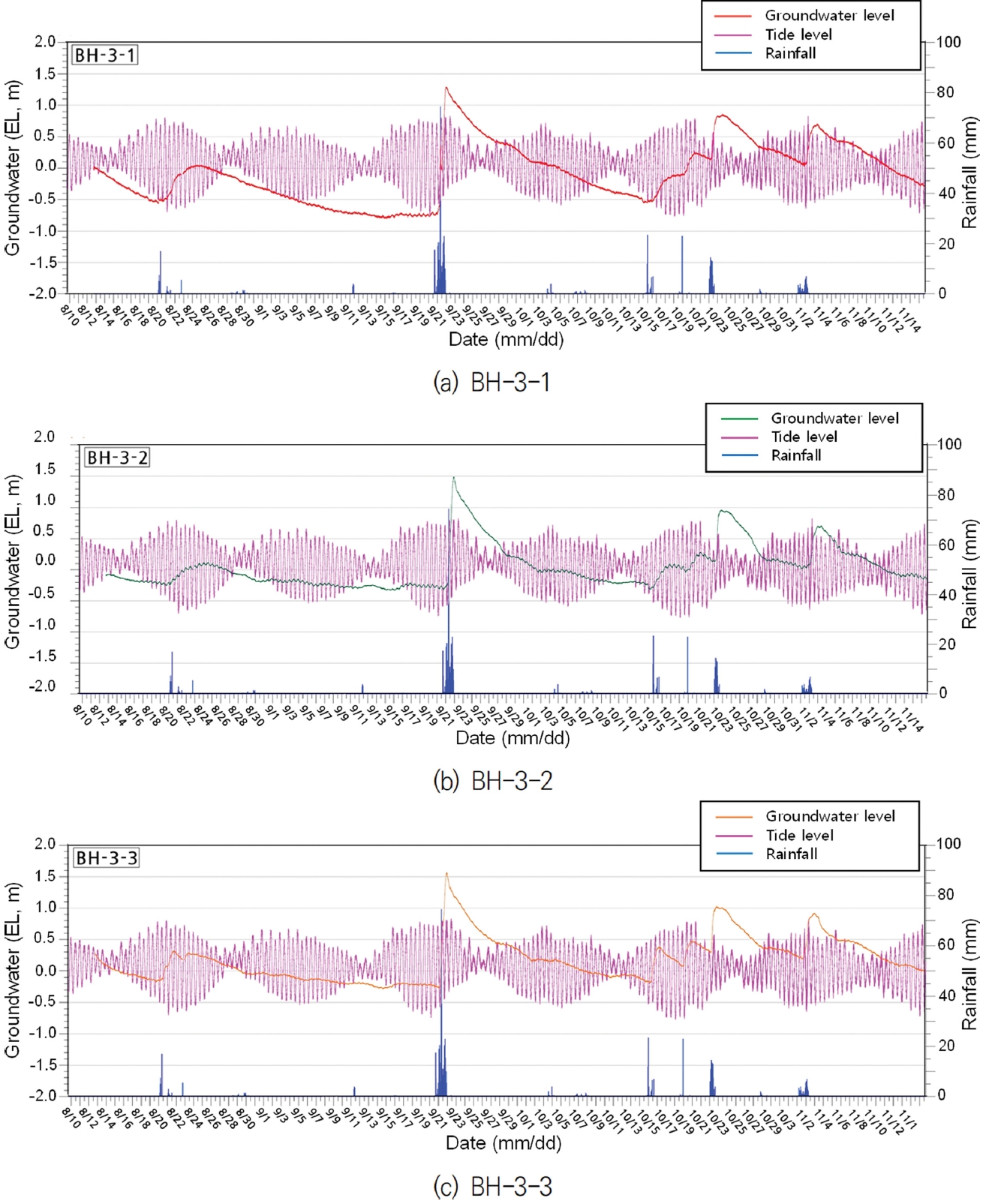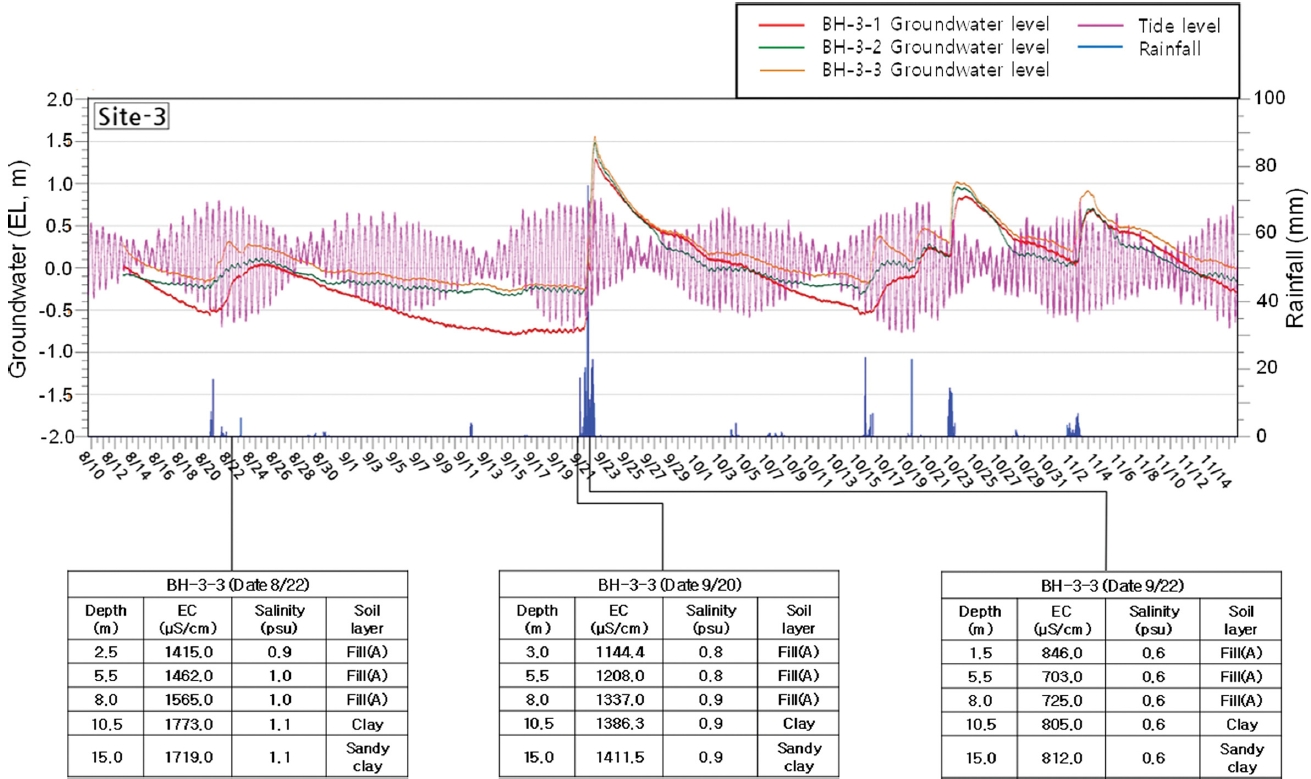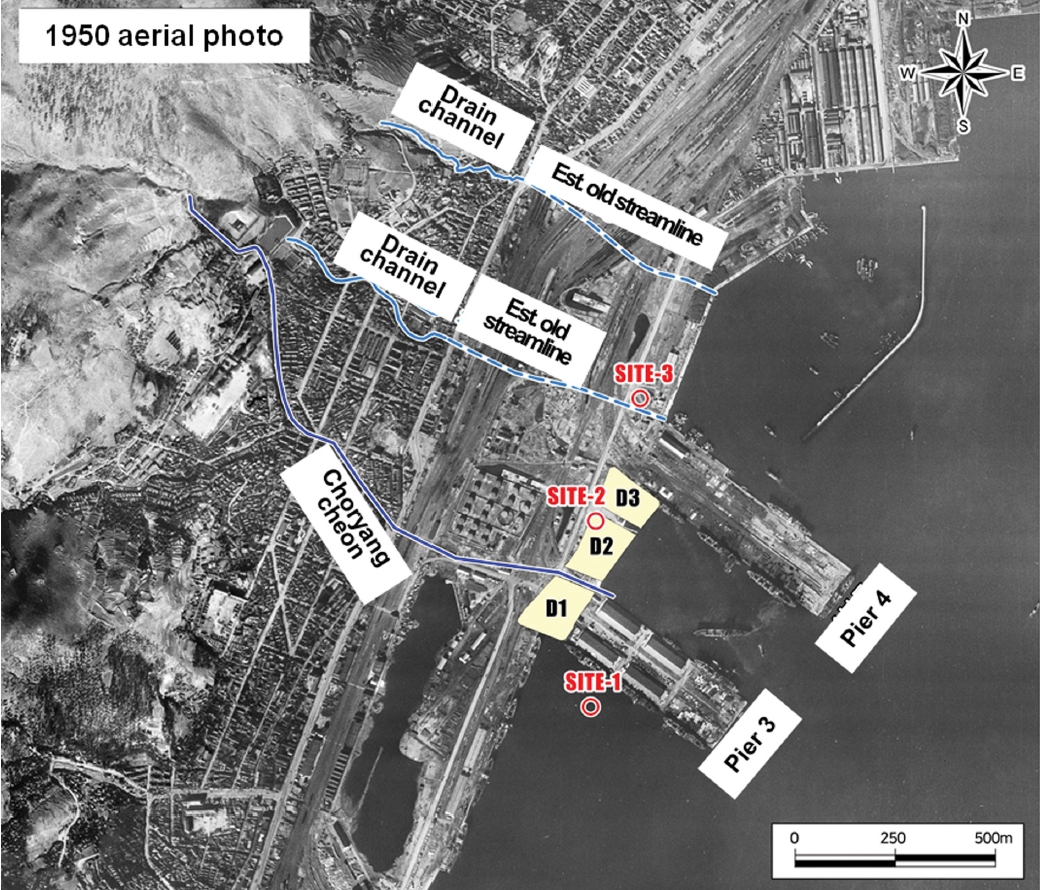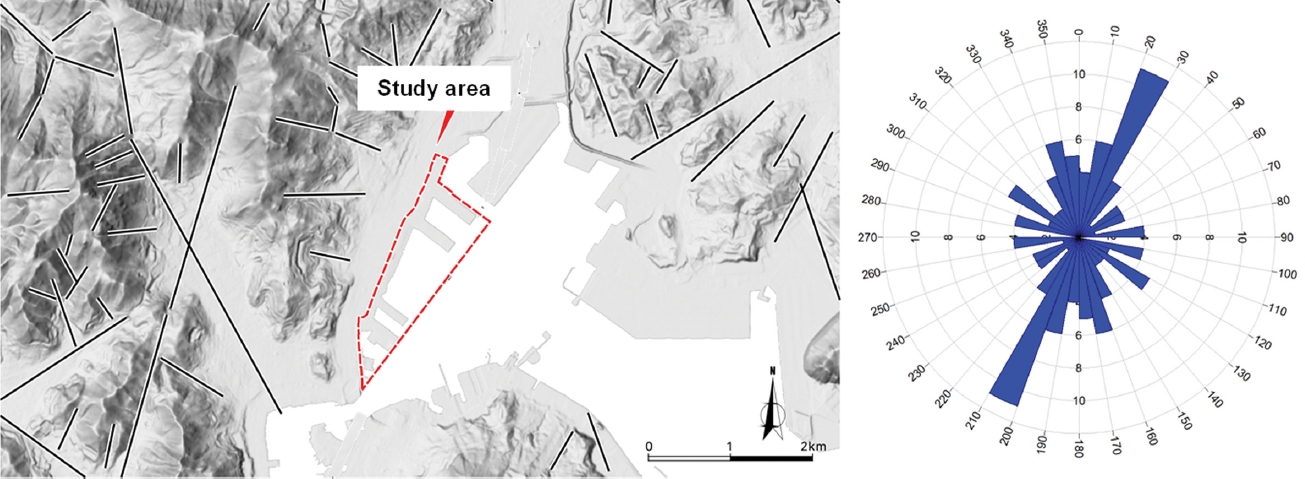1. 서 론
해안매립지는 사회적 경제적 필요성에 따라 오래전부터 장기간에 걸쳐 많이 조성되었다. 국외의 경우 네덜란드, 일본, 싱가포르가 대표적인 국가이고((Bi et al., 2012; Dore, 2013; Hoeksema, 2007; Jickells et al., 2016), 우리나라는 서남해안을 중심으로 인천, 군산, 광양, 부산 등이 대표 지역이다. 부산 지역의 대표적인 매립지로 북항 재개발사업지, 부산항 신항, 영도 지역 매립지, 용호만 매립지, 수영만 매립지 등이 있다. 북항 재개발사업지의 경우 일제강점기부터 항만조성을 위하여 해안을 매립한 지역으로 광복 이후에도 항만증설의 필요에 따라 추가적인 매립이 진행된 곳이다. 또한 2009년부터 북항 재개발사업 일환으로 넓은 지역에 걸쳐 해안매립이 이루어져 현재의 형태를 갖췄다.
이런 매립에는 적합한 매립재가 사용되어야 하지만 관리 기준이 부재했고 느슨했던 시기에는 다양한 매립재가 재료로 사용될 수밖에 없었다. 특히 장기간에 걸쳐 오랫동안 매립이 진행된 지역일수록 그 시기의 지역 상황과 환경적인 영향에 따라 다양한 재료가 매립에 사용되었다. 북항 재개발 사업지의 경우, 지형 특성과 1세기에 걸친 장기간의 매립영역 확장으로 매립층의 두께가 위치별로 서로 다르고, 일반 매립층과 준설매립층이 혼재되어 있다. 매립토사 외 나무말뚝, 호안축조용 사석, 석축 등과 같은 재료가 일부 분포하고 있다.
다양한 재료가 매립된 해안매립지의 지하수위는 위치별 불균질성이 높다. 지하수위는 지하의 지층이나 암석 사이의 빈 틈을 채우고 있거나 흐르는 지하수의 지표면으로부터 지하수면까지의 깊이이다. 지하수위 변동은 수문 및 기상 조건, 지형, 대수층의 특성 및 지하수 취수 등 다양한 외부적 요인에 의해 결정되는데 특히 대수층의 특성과 밀접한 관련이 있다. 상기 요인 중 해안매립지에서의 주된 지하수위 변동 요인은 강우 및 조석 간만과 지형 및 지질의 영향 등이 클 것이다(Gribovszki et al., 2010; Jung et al., 2021; Liu et al., 2023; Shi et al., 2023; Jasechko et al., 2024). 또한 매립지 내에서는 이미 시공된 지하구조물의 영향도 국지적으로 지하수의 불규칙한 흐름을 일으킬 것이다.
기존 설계기준(KDS 11 10 10)에서 지하수위 측정은 시추공을 통해 시추 종료 후 24, 48, 72시간에 수위를 측정하는 것으로 되어있다(Ministry of Land, Infrastructure and Transport, 2021a). 지하안전관리에 관한 특별법 시행령」[별표2] [별표6]에 따른 공내지하수위측정도 동일하게 제시되어 있다. 측정된 지하수위는 강우에 따른 지하수위 상승고를 반영하여 설계지하수위를 산정한다. 여기서 지하수위 상승고는 강우조건 국가기상종합정보(기상청)를 활용하여 과업지역 최근 50년간 최대강우량이 발생한 시점을 기준으로 이후 30일 이상의 실측 강우량을 적용한다(Korea Government, 2024a).
경우에 따라 지하수 관측망 자료를 설계지하수위로도 사용한다. 지하수 관측망은 지역 또는 유역별로 선정된 대표지점에서 주기적으로 지하수 수위·수질 현황을 관측하여 시간에 따른 지하수의 물리적 화학적 변화를 파악하기 위한 시스템이다. 하지만 아쉽게도 지하수 관측망이 해안매립지에 설치된 곳은 거의 존재하지 않는다.
지하수위는 해안매립지의 흙막이벽체 및 차수공법에서 누수와 관련된 중요한 요소이다. 굴착 시 가설흙막이벽체 후면 지하수위가 조사 수위 이상으로 상승될 가능성이 있는 경우에는 가설흙막이 벽체 설계 시 현장 여건을 감안하여 침투해석을 실시하고 변경된 지하수위를 적용하여 설계하여야 한다(Kaiser and Hewitt, 2011; Markham, 2012; Lee et al., 2018; Cashman and Preene, 2020; Ministry of Land, Infrastructure and Transport, 2024b, 2024c). 차수공법 선정에도 심도별 지층뿐만 아니라 지하수위도 같이 고려하여 선정하여야 한다. 또한 지하수에 존재하는 염분 해안매립지에서는 중요하다. 왜냐하면 지하수에 존재하는 염분의 양에 따라 차수 재료의 선택이 달라지기 때문이다.
지하수위 측정은 해안매립지에서 매우 중요한 요소지만, 지금까지 해안매립지에서 지하수위 측정 방법과 장기적인 지하수위 변동 특성에 대한 구체적인 국내 사례 연구는 거의 이루어지지 않았다. 따라서 본 연구에서는 해안매립지에서 지하수위 측정 방법을 제시하고, 장기간 측정된 지하수위의 변동 특성을 파악하였다.
2. 연구 대상 현장
2.1 지하수위 조사 위치
부산 지역에서 여러 매립지가 존재하는데 본 연구는 북항 재개발사업지를 대상으로 선택하였다. 사업지 내 부지사용 협의가 가능하고 장기간 수위측정이 가능한 부지를 현장답사 및 협의를 통하여 총 3곳을 선정하였다(Fig. 1).
Site-1은 기존 지하주차장(지하 1층)과 인접하고 앞쪽에 해수순환 수로가 있는 위치로 수로 건설 당시 하부는 DCM으로 지반이 개량되었다. Site-2는 주상복합 건물 사이에 위치하는 구역으로 좌측에서 이미 건설되어 사용 중인 주상복합 지하 4층 건물이 위치하고, 우측에는 상부골조 공사가 거의 완료되고 있는 지하 5층 건축물이 위치한다. Site-3은 Site 2에서 100 m 정도 오른쪽으로 이격된 구역으로 뒤쪽으로는 지하차도 공사가 진행 중이고 현재 토사 야적장으로 사용되고 있다. 수위 측정 장치 망실과 각 site에서의 수위 차이를 알아보기 위하여 site 별로 3개의 시추공을 10 m 간격으로 뚫어 360o로 수위를 측정하였다. 각 위치별 좀 더 자세한 시추 위치는 Fig. 2와 같다.
2.2 지층 상태
Figs. 2~4는 각 site 별 지하수위 측정 시추공 상세 위치와 토질주상도를 같이 도시한 것이다. 지층상태는 상부로부터 매립층, 점토층, 자갈층, 풍화토 층으로 구성되며 각 지층별 특성은 각 site 별로 차이가 있다.
2.2.1 Site-1 지층
Site-1의 최상부 매립층은 북항 재개발 부지조성을 위하여 과거 바다였던 구역을 인위적으로 매립한 지층이다. 특히 매립층은 외부에서 토사를 반입하여 매립한 일반토사 매립층(A)과 주변 바다의 퇴적토를 준설매립한 준설토사 매립층(B)으로 구분된다(Fig. 2).
매립층 최상부는 일반매립층(A)으로 황갈~황회색을 띠고 점토, 모래, 자갈이 혼합된 토성을 보이며 외부토사를 매립재로 사용한 층이다. 심도에 따라 토성이 변화한다. 상부구간과 하부구간은 구성물질의 특성은 유사하나 자갈과 점토 함량의 차이로 구분한다. 준설매립층(A)는 부지조성 당시 주변 해저의 퇴적층을 준설하여 매립한 지층으로 주로 황갈~회색을 띠는 모래층으로 분류된다. 모래는 세립~중립질 입경의 석영사, 장석사 등으로 구성되며 위치에 따라 소량의 잔자갈이 함유되기도 한다. 반면 준설매립층(B)은 주로 암회색의 점토층이며 중~고소성의 점성을 보인다. 표준관입시험 결과 매우약함~약함의 연경도를 보여 일반 퇴적층의 점토층과 유사한 특징을 보인다. 일반매립층(B)는 매립층의 최하단부에 분포하는 지층으로 주로 황갈~회갈색을 띠는 모래섞인 점토이다. 점토는 저~중소성의 점성을 가지며 모래는 세립~조립질 입경의 석영사, 장석사, 암편사로 구성된다.
점토층은 해성기원 퇴적층으로 주로 암회색을 띠며 중~고소성의 점성을 보인다. 패각편이 함유되어 나타나며 약함~중간정도 단단한 연경도를 보인다.
자갈질모래층은 육성기원 퇴적층으로 과거 해퇴시기에 해안선을 이루는 지역에 육지의 산체에서 토석이 이동집적되어 형성된 붕적층으로 추정된다. 주로 회갈~회록색을 띠는 점토섞인 자갈질모래~모래섞인 자갈질점토이다. 점토는 저~중소성의 점성을 보이며 모래는 세립~조립질 입경의 석영사, 장석사, 암편사로 구성된다. 자갈은 안산암질암의 역으로 구성되며 Φ20~80 mm 크기로 30~40% 내외의 함량을 보인다.
풍화토는 조사지역에 분포하는 기반암인 안산암질암이 완전풍화작용을 받아 형성된 풍화잔류토로서 점토질모래~점토화되어 분포한다. 원암의 조직이 잔존되고 비풍화자류세편이 소량 잔류하기도 한다. 나머지 site-2와 site-3도 동일하다.
2.2.2 Site-2 지층 분포
최상단 매립층(일반토사)은 과거 부산항 축조시에 매립된 지층으로 판단된다. 하지만 site-1과 같이 준설토사 매립층은 확인되지 않으며 일반토사 매립층만 분포하는 것으로 확인된다. 본 지층은 황갈~황회색을 띠는 점토, 모래, 자갈의 혼합층으로 외부토사를 매립재로 사용한 일반매립층으로 분류된다. 심도에 따라 토성의 변화가 있다. 매립층 상부구간과 하부구간은 구성물질의 특성은 유사하나 자갈과 점토 함량의 차이가 있다. 상대적으로 상부구간에서 분포하는 자갈은 크기가 크고 높은 함량을 보이는 것으로 확인된다(Fig. 3).
점토층은 해성기원 퇴적층으로 주로 암회색을 띠는 점토층으로 중~고소성의 점성을 보인다. 패각편이 함유되어 나타나며 매우 약함~약함의 연경도를 보인다.
자갈질점토층은 육성기원 퇴적층으로 주로 황갈, 황회, 회갈 등의 색을 띠는 모래섞인 자갈질점토으로 일부 자갈섞인 모래질점토의 특성을 보인다. 점토는 저~중소성의 점성을 보이며 모래는 세립~조립질 입경의 석영사, 장석사, 암편사로 구성된다. 자갈은 안산암질암의 역으로 구성되며 Φ20~110 mm 크기로 20~30% 내외의 함량을 보인다.
2.2.3 Site-3 지층분포
Site-3 구역의 최상부 매립층은 부산항 축조시에 매립된 지층으로 판단된다. 그래서 site-1 구역과 같이 준설토사 매립층은 확인되지 않으며, site-2 구역과 같이 일반토사 매립층만 존재한다. 본 지층은 최상부에 분포하는 지층으로 황갈~황회색을 띠는 점토, 모래, 자갈의 혼합층으로 외부토사를 매립재로 사용하였다. 상부구간과 하부구간은 구성물질의 특성은 유사하나 자갈과 점토 함량의 차이로 구분한다. Site-2 구간과 마찬가지로 상대적으로 상부구간에서 분포하는 자갈은 크기가 크고 높은 함량을 보인다(Fig. 4).
점토층은 해성기원 퇴적층으로 매립 전 과거 해저면을 이루는 원지반이다. 주로 암회색을 띠는 점토층으로 중~고소성의 점성을 보인다. 패각편이 함유되어 있고 약함 연경도를 보인다.
모래질점토층은 육성기원 퇴적층으로 본 층은 과거 해퇴 시기에 해안선을 이루는 지역에 육지의 산체에서 토석이 이동집적되어 형성된 붕적층으로 추정된다. 주로 황갈, 황회, 회갈 등의 색을 띠는 소량의 자갈 섞인 모래질점토이다. 점토는 저~중소성의 점성을 보이며 모래는 세립~조립질 입경의 석영사, 장석사, 암편사로 구성된다. 자갈은 안산암질암 역으로 구성되며 Φ20~50 mm 크기로 10% 내외의 함량을 보인다.
3. 지하수위 측정 방법
연구 지역에서는 시행된 지하수위 측정장치 설치 구체적인 작업순서는 시공 중 지반계측(KCS 11 10 15) 기준에 따라 다음과 같이 수행하였다(Ministry of Land, Infrastructure and Transport, 2021b).
장기수위 측정관의 자재는 하부 캡 – 무공관 – 유공관(스트레이너) – 보호박스로 구분된다. 하부 캡은 시추공 바닥에서 슬라임의 유입을 방지하고 원활한 측정관의 삽입을 위한 장치이다. 무공관은 시추공의 최하단부 및 최상단부에서 슬라임 및 토사의 유입을 방지하기 위한 원형관이다. 유공관은 스트레나라고도 하며 지하수의 유동이 원활하게 전 구간에 틈을 만든 원형관이다. 특히 공 내부에서의 공벽 폐색영향을 최소화하기 위하여 공벽과 유공관 사이에 여재(자갈)를 설치하였다. 마지막으로 보호박스를 설치하여 강우 등의 지표수 유입을 방지와 지표에 노출되는 수위측정관의 파손 및 훼손을 방지하도록 하였다. Fig. 5는 지하수위 측정 각 부품에 대한 것이며, Fig. 6은 지하수위 측정 모식도이다.
장기 수위측정기는 압력식 수위계를 사용하는 것이 적정하다. 압력식 수위계는 수위의 변화에 따른 압력값을 프로브의 끝단에 장착된 압전소자가 감지하여 그 감지된 신호를 전류 신호로 변화시켜 수위의 변화를 측정한다. 본 연구에 사용된 수위계는 직경 22 mm, 길이 135 mm, 중량은 95 g이다. 계측 허용 수위는 10~100 m, 수온은 -20oC~80oC로 오차율은 수위 ± 0.05%, 수온 ± 0.1oC이다. 자체 내장 배터리를 가지고 있다.
수위계는 퇴적물이 쌓이면 측정값에 영향을 미칠 수 있으므로 외부를 깨끗하게 유지해야 하고, 관측공 내 퇴적물에 묻히지 않도록 설치 심도를 확인해야 한다. 장기간 염수에 접촉하였을 경우 많은 부식이 발생할 수 있으므로 유지관리가 필요하다.
수위계 설치위치는 수동 수위측정기로 측정한 지하수위를 고려하여 site-1 구역의 경우 지표하(GL-) 10 m 지점, site-2, 3 구역의 경우 지표하(GL-) 15 m 지점에 설치하였으며, 연속적인 수위 변화를 파악하기 위하여 5분 간격으로 측정하였다.
지하수위 측정은 자동 수위측정기를 이용하여 3개월간 연속적으로 측정하고 각 관측공에서 측정 기준 지점을 선정하여 동일 시간에 측정을 할 수 있도록 하였다. 또한 측정 중간에 수동 수위측정기를 이용하여 수위를 보정 하였다. 측정된 자료는 측정 지점으로부터 지하수 심도(지표에서 지하수위까지의 깊이)로 표시한다.
4. 장기 지하수위 측정 결과 및 분석
장기 지하수위 계측은 한 분기에 해당하는 3개월 동안(2024년 8월~11월) 이루어졌다. 최소한 3개월간의 계측기간이 이 구역의 지하수위 변동을 대표할 수 있을 거라 판단되어 선정하였다.
해당 지역이 해안매립지 인점을 감안하여 측정된 장기 지하수위 변화와 함께 조위관측소의 실측조위 데이터(국립해양조사원-바다누리 해양정보서비스) 및 AWS의 강수량 데이터(기상청-날씨누리)를 중첩하여 작성하였다.
실측조위는 사리-조금 및 밀물-썰물에 따른 조위변화를 측정한 값이다. 해안을 매립한 지역의 경우 해양의 조위에 따라 지하수위의 변동이 있다(El-Alfy et al., 2020). 그리고 매립지는 매립재의 종류가 다양하고 불균질하여 조위의 영향도 동일하지 않고 국부적으로 차이를 보일 수 있다. 해안 매립층에서 해수의 유동이 원활하다면 조위의 변화에 따라 지하수위의 변화가 민감하게 반응을 할 것이다. 따라서 각 site별로 조위변화에 따른 지하수위의 변화를 비교하고자 조위데이터를 중첩하여 작성하였다.
강수량의 양에 따라 지반으로 침투하는 유량의 차이가 발생할 것이다. 강우 침투유량에 따라 지하수위의 변동이 있을 것이다. 침투유량의 경우 조사대상 부지 자체의 침투율도 영향이 있을 수 있지만 현재 또는 과거의 계곡부, 하천지역 등 지형에 따른 민감하게 반응할 것이다. 따라서 각 site 별로 강수량에 따른 지하수위의 변화를 비교하고자 강수량 데이터를 중첩하여 작성하였다.
시추공 내에 분포하는 지하수의 심도별 염분을 측정하여 그래프 상에 같이 도시하였다. 염분 측정결과는 각 site 별로 해수침입 영향의 차이가 있는지를 간단히 판단할 수 있다. 또한 강우 전과 후의 염분을 비교하여 각 site 별로 담수의 영향성 비교하였다.
4.1 Site-1 결과 및 분석
Site-1의 지하수 수위 변화는 BH-1-2공의 수위가 가장 높고, BH-1-3, BH-1-1공의 순서로 수위가 분포한다. 전반적으로 최대 해수면 높이인 EL(+)0.5 m 심도에서 수위를 유지하고 강우시에는 수위가 약간 상승하였다가 시간이 경과함에 따라 하강하여 EL(+)0.5 m 내외의 심도로 유지하는 경향을 보인다(Fig. 7).
실측 조위변화에 대한 수위 변화는 반월 주기인 사리-조금과 하루 주기인 밀물-썰물에 대하여 분석하였다. 3개 측정공 모두 사리-조금에 대한 반응과 밀물-썰물에 대한 반응은 낮다. Site-1 구역의 위치는 과거 해안을 매립한 곳이며 현재 바다에 인접한 위치로 조석에 대한 반응이 민감할 것으로 추정되었으나 실제 측정된 수위변화의 반응성은 3개 site 구역 중 가장 낮다(Fig. 7).
측정기간 중 내린 강수량에 따른 수위 변화를 분석하면, 3개 측정공 모두 강우 이후 수위가 상승하였으며 변동폭은 최대 0.5 m 내외인 것으로 확인되었다. 강우 후 상승한 수위는 시간이 경과됨에 따라 서서히 하강하여 EL(+)0.5 m 심도로 수렴한다(Fig. 7).
Site-1 구역에서 염분 측정은 BH-1-3공에서 3회에 걸쳐 측정하였다. 지하수위 측정 초기에 해당하는 8월 22일은 0.8~3.2 psu의 염분이 측정되었다. Site-1에 인접한 수로구간에서 해수를 채취하여 염분을 측정한 결과 19.72 psu로 지반내의 염분은 인접 해수기준으로 약 16%의 농도로 분포한다. 이와 같은 결과로 미루어 보아 지반내의 지하수는 해수로만 이루어지지 않고 육상부의 담수와 섞인 상태로 분포하는 것으로 판단된다. 강우 전 9월 20일에 측정한 염분은 0.8~2.2 psu의 농도를 보였으며, 강우 직후 9월 22일에는 0.5~1.4 psu 농도가 낮아져 강우 이후에 염분은 낮아진다. 따라서 site-1 구역은 강우의 침투로 인한 염분의 변화가 있는 것으로 보아 강우의 영향이 있다(Fig. 8).
Site-1 구역 장기 지하수위 측정 결과, 측정 위치가 해안에 인접하여 위치하나 조위에 대한 수위변화는 나타나지 않았다. 이는 주변 구조물(지하주차장의 벽체, 수로의 지반개량시공 등)의 영향으로 조석의 직접적인 영향을 받지 않기 때문이다. 또한 강수량 대비 수위의 변화는 최대 0.5 m이며 강우 이후의 염분이 강우 직전에 비해 낮아지는 경향을 보이므로 강우의 영향을 받는다. Site-1의 장기수위 측정결과에서 나타나듯이 바다에 인접한 위치에서도 주변의 구조물의 시공현황에 따라 조위의 영향이 다양하게 나타날 수 있다(Fig. 8).
4.2 Site-2 결과 및 분석
Site-2의 지하수 수위 변화는 BH-2-1공의 수위가 가장 높게 분포하고, BH-2-2, BH-2-3의 순서로 수위가 분포한다. 장기수위 측정 초기에는 EL.0.2~0.7 m 구간으로 3공 모두 인접한 심도에서 수위가 형성되었으나 시간이 경과됨에 따라 전체 측정공의 수위가 하강하는 경향을 보이며 9월 21일 강우 이후는 수위 하강과 상승이 반복되는 경향을 보인다(Fig. 9).
조위변화에 대한 수위 변화를 보면, BH-2-1공에서는 사리-조금에 대한 반응은 명확히 나타나지 않는다. 또한 밀물-썰물에 대한 반응은 미약하게 나타났다. BH-2-2공에서는 사리-조금에 대한 반응은 명확히 나타나지 않으나 밀물-썰물에 대한 반응은 나타나며 수위 변동값은 10~20 cm 내외로 측정되었다. BH-2-3공에서는 BH-2-2공과 유사한 결과가 나타났다(Fig. 9).
측정 기간 중 내린 강수량에 따른 수위 변화를 보면, 3개 측정공 모두 강우 이후 수위가 상승하였으며 변동폭은 10~30 cm 내외로 나타났다. 강우 후 상승한 수위는 시간이 경과함에 따라 서서히 하강한다(Fig. 9).
Site-2 구역에서 염분 측정은 BH-2-3공에서 3회에 걸쳐 측정하였다. 지하수위 측정 초기 8월 21일에 실시한 염분 측정에서 1.2~4.4 psu의 농도를 보였다. Site-2에 인접한 지역의 해수를 채취하여 염분을 측정한 결과 17.2 psu로 지반내의 염분은 인접 해수기준으로 약 25%의 농도를 가진다. 이와 같은 결과로 미루어 보아 지반내의 지하수는 해수로만 이루어지지 않고 육상부의 담수와 섞인 상태로 분포한다(Fig. 10). 강우 전 9월 19일에 실시한 염분 측정에서 1.1~3.3 psu의 농도를 보였으며, 강우 직후 9월22일 실시한 측정에서 1.1~3.2 psu로 강우에 따른 염분의 변화는 없었다. 따라서 site-2 구역은 강우의 침투로 인한 염분의 변화는 없는 것으로 보아 강우의 영향은 적다.
Site-2 구역에서 측정한 장기지하수위 측정 결과를 종합하면, site-1 구역에 비해 조위에 대한 수위변화는 나타나나 수위의 변동값은 다소 적다. 그러나 site-1에 비해 해안과 거리가 멀지만 조위의 영향을 더 받는다. 또한 강수량 대비 수위의 변화는 site-1에 비해 변동폭이 작고 강우 전, 후의 염분이 변화하지 않아 site-2 구역의 경우 담수(강우)보다는 해수에 영향을 더 받는 지역이다. 특히 site-2의 경우 측정 초기에서 시간이 지날수록 수위가 지속적으로 하강하는 경향을 보이며 9월 21일 강우 이후에는 강우시기에 따라 수위 상승과 하강을 반복하나 어느 정도 수위를 유지하는 것으로 나타났다. 수위가 하강하는 원인은 정확히 파악할 수는 없지만 주변에서 구조물 공사 진행에 따른 양수작업 영향으로 추정된다(Fig. 10).
4.3 Site-3 결과 및 분석
Site-3에서는 BH-3-3공의 수위가 가장 높고, BH-3-2공과 BH-3-1공의 수위는 서로 교차하는 경향을 보인다. 각 시추공에서 수위가 일정하지 않고 변동하는 것은 강우, 주변 구조물, 지형 등 여러 요인에 의해 지하수위가 변화함을 의미한다. 따라서 site-3 구역은 site-1, 2에 비해 지하수위 변화에 더 민감하다(Fig. 11).
3개 측정공 모두 사리-조금에 대한 명확한 반응은 없으나, 밀물-썰물에 대한 미약한 반응이 확인되었다. Site-1과 비교하면 조석에 대한 반응은 높지만, site-2와 비교하면 상대적으로 낮다. 과거 일제강점기 매립지역으로 추정되는 site-3 구역은 바다와 가까운 위치에도 불구하고 수로 등의 구조물 때문에 조석에 대한 민감도가 낮다(Fig. 11).
Site-3에서는 강수량에 따른 수위 변화가 site-1과 site-2보다 훨씬 더 크게 나타났다. 3개 측정공 모두 강우 후 수위가 급상승하며, 수위 변동폭은 최대 2.0 m에 달했다. 강우 후 상승한 수위는 시간이 지나면서 서서히 하강하며, 이후 강우에 따라 수위가 상승과 하강을 반복하는 경향을 보였다(Fig. 11).
Site-3 구역에서 염분 측정은 BH-3-3공에서 3회에 걸쳐 측정하였다. 지하수위 측정 초기 8월 22일에 0.9~1.1 psu로 염분이 측정되었는데 site-1, 2 구역에 비해 상대적으로 낮은 범위를 보인다. Site-3에 인접한 물양장에서 해수를 채취하여 염분을 측정한 결과 19.9 psu로 지반내의 염분은 인접 해수기준으로 약 5% 내외의 농도로 분포한다(Fig. 12). 강우 전 9월 20일에 실시한 염분은 0.8~0.9 psu의 농도를 보였으며, 강우 직후인 9월 22일에는 0.6 psu의 농도를 보여 강우에 따라 염분이 낮아지는 경향을 보인다. 따라서 site-3 구역은 site-1, 2 구역에 비해 기본적인 염분도 낮으며 담수(강우 포함)의 침투로 인한 변화 또한 있는 것으로 보아 해수 보다는 담수의 영향이 크다.
종합적으로 살펴보면, site-3 구역은 조석에 의한 수위 변화가 site-1 구역보다는 크고, site-2 구역보다는 적은 특징을 보인다. 이는 site-3가 해안과 가까운 위치에 있지만, 조위의 영향을 상대적으로 덜 받는다는 의미이다. 또한, 강수량에 따른 수위 변화가 site-1과 site-2에 비해 급격하게 나타나며, 그 변동폭도 약 2.0 m로 가장 크다. 염분 역시 site-1이나 site-2보다 낮고, 강우 후에는 더욱 낮아지는 경향을 보인다. 이러한 특성으로 인해 site-3 구역은 해수보다는 담수, 즉 강우의 영향을 더 많이 받는 지역이다. 이러한 현상은 site-3의 지형과 지질적 특성에서 유추할 수 있다.
Fig. 13은 1950년대 항공사진, 하천정비사업계획, 지적도상 구거 위치 등을 바탕으로 엄광산에서 발원해 부산항으로 유입되는 하천 지역을 분석한 결과이다. 초량천은 3부두 동측에 그 형태가 남아 있으며, 상류에서 분기되어 site-3 구역으로 유입된 하천이 있었던 것으로 추정된다. 이 과거 하천은 복개 또는 매립되었으나, 주변은 강우가 원활하게 이동할 수 있는 지층으로 분포하고 있어, 강우 시 하류 구간에서 지하수 유량이 증가한 것으로 판단된다.
Fig. 14는 음영기복도와 위성영상을 활용한 선구조 분석 결과로, 연구 지역의 지형 특성과 선형구조를 파악했다. 선구조의 주 방향은 북북동(NNE)으로 서측 엄광산에서 동서 또는 남동 방향으로 발달한 선구조는 계곡부와 일치한다. 따라서 site-3 구간의 급격한 수위 변화는 과거 하천지역과 단층대 분포 등 여러 요인으로 인한 결과로 보인다.
5. 결 론
1) 장기 지하수위 측정방안 관련, 자재는 하부 캡 – 무공관 – 유공관(스트레이너) – 보호박스로 구분된다. 장기 지하수위는 오차율 수위 ± 0.05%, 수온 ± 0.1oC을 가진 배터리 내장형 압력식 수위계를 이용할 것을 추천한다. 수위 측정은 장치 망실과 각 site에서 360o로 수위 차이를 알아보기 위하여 site 별로 3개의 시추공을 10 m 간격으로 설치하여 수행하였다.
2) 동일 구역 해안매립지에서 장기지하수위 측정 결과, 지형적인 요소나 지질적인 요소, 그리고 지반내 매립재나 이미 시공된 지하구조물로 인하여 구역별로 지하수위의 변동성이 크게 나타났다.
3) 조위에 의한 지하수위 변화, site 별로 조위 영향이 다른 것으로 나타났다. 지반내 이미 시공된 구조물(지하주차장의 벽체, 수로의 지반개량시공 등)의 영향 때문에 해안에 매우 근접하여 위치한다고 조위 영향이 크지는 않는 것으로 나타났다. 조위 영향이 가장 크게 나타난 구역에서 수위 변동값은 10~20 cm 내외로 확인되었다.
4) 강수량에 의한 지하수위 변화, 강우 이후 모든 site에서 수위 상승이 관측되었다. 하지만 지하수위 증가폭과 시간에 따른 상승 및 하강 속도가 각 site 별로 큰 차이가 있다. 강우에 가장 민감한 구역에서 수위 변동폭이 2.0 m 내외로 확인되었다. 이유는 이 구역이 과거 하천지형이고 단층대가 통과하는 지질특성을 갖고 있기 때문이다.
5) 염분의 변화, 각 site 별 그 영향의 정도는 서로 다른 것으로 나타났다. 바다와 근접 거리에 상관없이 염분이 차이나며 강우 전, 후의 염분 감소량도 서로 다른 것으로 나타났다.







